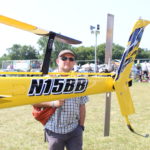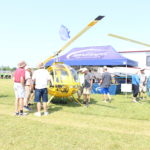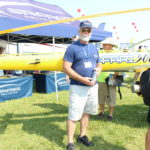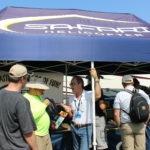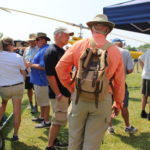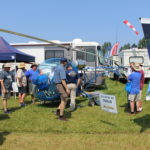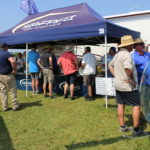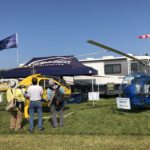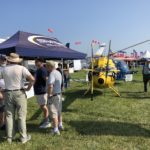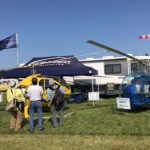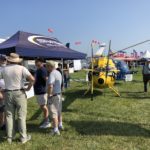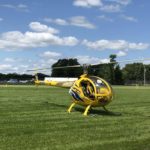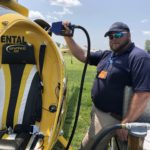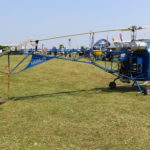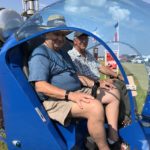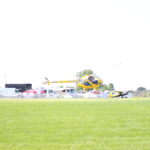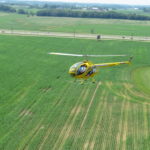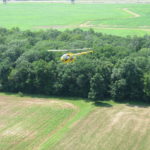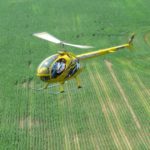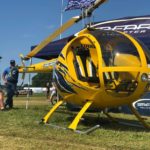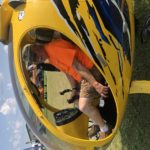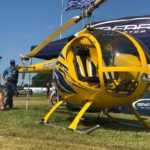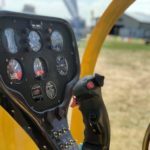MI-003 Horizontal Stabilizer
Mandatory Inspection and Modification
April 6, 2015
We have observed evidence of fatigue cracking at the location of a horizontal stabilizer
positioning flange, which has the potential to break in flight.
While it should not be a catastrophic failure if the helicopter is being operated within the Center
of Gravity envelope, it would change the attitude of the helicopter and be very alarming to the
pilot. In the event of such a failure, the cyclic should be moved back in a controlled fashion (not
abruptly) to correct the attitude of the helicopter. The collective should not be lowered
abruptly. The aircraft should be landed normally as soon as practical.
In manufacturing the center tube of the horizontal stabilizer, a circular flange of 4130 Chromoly
steel is slid onto the tube and welded in place. This is matched to a slightly larger
piece of tubing and flange which is welded to the tail boom.
It is necessary to remove the horizontal stabilizer and inspect the interior and exterior of the
tube at the location of the circular flange. Unless the sheet metal that forms the horizontal
stabilizer wing is attached at adequate distance from the flange to allow inspection, the sheet
metal skin must be removed to inspect the flange on the outboard side.
On helicopters in operation less than 24 months, this inspection should be accomplished at the
next annual condition or 100 hour inspection. On helicopters older than 24 months, the inspection
should be accomplished before next flight. This inspection should be added to the annual
condition inspection for your particular aircraft.
Area to be inspected:

Inspection Method:
Area of concern should be inspected using Liquid Penetrant Inspection. A great deal of information
about conducting this type of inspection is available including this excerpt from the FAA handbook
“Inspection Fundamentals”:
“Liquid Penetrant Inspection is a nondestructive test for defects open to the surface in parts made
of any nonporous material. It is used with equal success on such metals as aluminum, magnesium,
brass, copper, cast iron, stainless steel, and titanium. It may also be used on ceramics, plastics,
molded rubber, and glass. Penetrant inspection will detect such defects as surface cracks or
porosity. These defects may be caused by fatigue cracks, shrinkage cracks, shrinkage porosity, cold
shuts, grinding and heat treat cracks, seams, forging laps, and bursts. Penetrant inspection will
also indicate a lack of bond between joined metals.
The main disadvantage of penetrant inspection is that the defect must be open to the surface in
order to let the penetrant get into the defect. For this reason, if the part in question is made of
material which is magnetic, the use of magnetic particle inspection is generally recommended.
Penetrant inspection uses a penetrating liquid that enters a surface opening and remains there,
making it clearly visible to the inspector. It calls for visual examination of the part after it
has been processed, increasing the visibility of the defect so that it can be detected. Visibility
of the penetrating material is increased by the addition of one of two types of dye, visible or
fluorescent.
The visible penetrant kit consists of dye penetrant, dye remover emulsifier, and developer. The
fluorescent penetrant inspection kit contains a black light assembly, as well as spray cans of
penetrant, cleaner, and developer. The light assembly consists of a power transformer, a flexible
power cable, and a hand-held lamp. Due to its size, the lamp may be used in almost any position or
location.
Briefly, the steps for performing a penetrant inspection are: 1. Thorough cleaning of the metal
surface. 2. Applying penetrant. 3. Removing penetrant with remover emulsifier or cleaner. 4.
Drying the part. 5. Applying the developer. 6. Inspecting and interpreting results. Interpretation
of Results
The success and reliability of a penetrant inspection depends upon the thoroughness with which the
part was prepared.
Several basic principles applying to penetrant inspection are:
1. The penetrant must enter the defect in order to form an indication. It is important to allow
sufficient time so the penetrant can fill the defect. The defect must be clean and free of
contaminating materials so that the penetrant is free to enter.
2. If all penetrant is washed out of a defect, an indication cannot be formed. During the washing
or rinsing operation, prior to development, it is possible that the penetrant will be removed from
within the defect, as well as from the surface.
3. Clean cracks are usually easy to detect. Surface openings that are uncontaminated, regardless of
how fine, are seldom difficult to detect with the penetrant inspection.
4. The smaller the defect, the longer the penetrating time. Fine crack-like apertures require a
longer penetrating time than defects such as pores.
5. When the part to be inspected is made of a material susceptible to magnetism, it should be
inspected by a magnetic particle inspection method if the equipment is available.
6. Visible penetrant-type developer, when applied to the surface of a part, will dry to a smooth,
even, white coating. As the developer dries, bright red indications will appear where there are
surface defects. If no red indications appear, there are no surface defects.
7. When conducting the fluorescent penetrant-type inspection, the defects will show up (under black
light) as a brilliant yellow-green color and the sound areas will appear deep blue-violet.
8. It is possible to examine an indication of a defect and to determine its cause as well as its
extent. Such an appraisal can be made if something is known about the manufacturing processes to
which the part has been subjected.
The size of the indication, or accumulation of penetrant, will show the extent of the defect and
the brilliance will be a measure of its depth. Deep cracks will hold more penetrant and will be
broader and more brilliant. Very fine openings can hold only small amounts of penetrants and will
appear as fine lines. Figure 8-4 shows some of the types of defects that can be located using dry
penetrant.

False Indications
With the penetrant inspection, there are no false indications in the sense that they occur in the
magnetic particle inspection. There are, however, two conditions which may create accumulations of
penetrant that are sometimes confused with true surface cracks and discontinuities.
The first condition involves indications caused by poor washing. If all the surface penetrant is
not removed in the washing or rinsing operation following the penetrant dwell time, the unremoved
penetrant will be visible. Evidences of incomplete washing are usually easy to identify since the
penetrant is in broad areas rather than in the sharp patterns found with true indications. When
accumulations of unwashed penetrant are found on a part, the part should be completely reprocessed.
Degreasing is recommended for removal of all traces of the penetrant.
False indications may also be created where parts press fit to each other. If a wheel is press fit
onto a shaft, penetrant will show an indication at the fit line. This is perfectly normal since the
two parts are not meant to be welded together. Indications of this type are easy to identify since
they are regular in form and shape.
If no evidence of fatigue cracking is found, an 8 inch insert of 7/8” x .058” 4130 Chromoly steel
tubing must be installed into the end of the stabilizer to extend the full length of the tail boom
mount. This insert should extend between the second and third rivet that secures the sheet metal
of the stabilizer to the center tube and must be welded to the center tube at the end of the spar.
Rivets which are removed to allow installation of the insert should be replaced with Cherry Max or
AN470AD-4-5 hard rivets. The sheet metal should be modified if necessary for it to be
positioned far enough away from the welded flange to allow future inspections without disassembling
the stabilizer.
If fatigue cracking is found, the horizontal stabilizer spar must be replaced with a new spar which
includes the required insert.

Please contact the factory with any questions. The factory can provide a new fabricated spar,
or materials as needed to comply with this inspection and modification requirement.
Document the inspection and results in the aircraft log book and forward any findings to the
factory.
Insert must extend from the end of the center tube to between the second and third rivet securing the sheet metal to the center
tube.
Sheet metal skin must be positioned away from the welded flange to allow inspection without disassembly.
